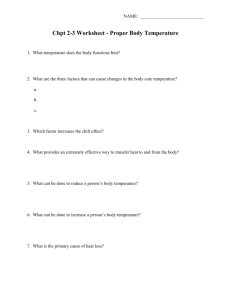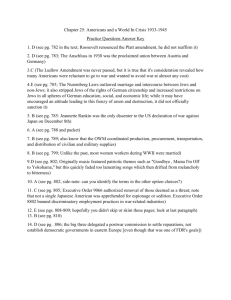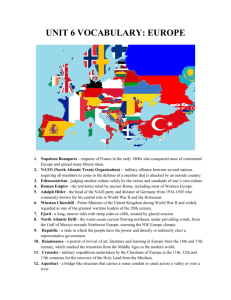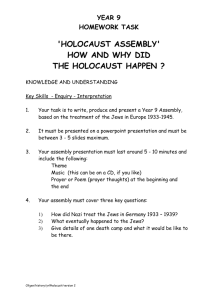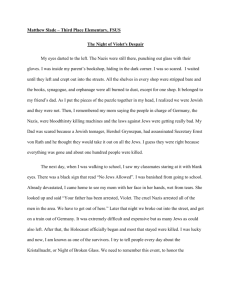Rescuers - Doral Academy Preparatory
advertisement
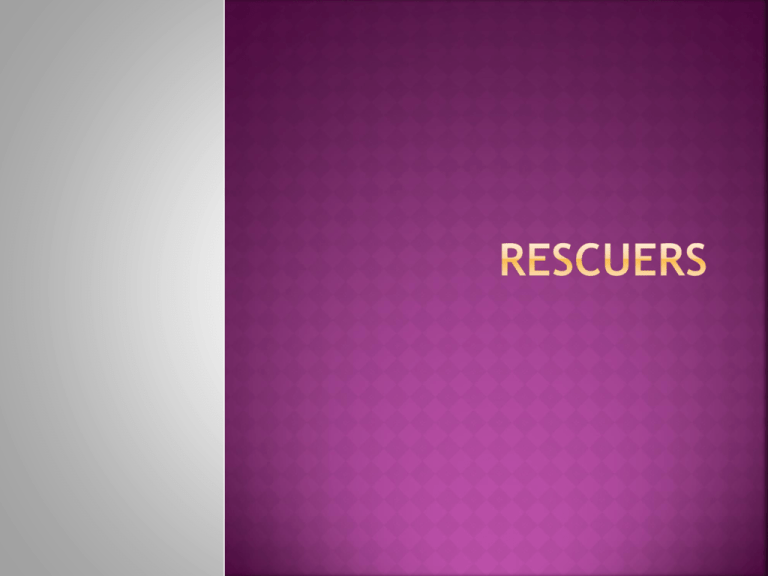
Rescuers are those who, at great personal risk, actively helped members of persecuted groups, primarily Jews, during the Holocaust in defiance of Third Reich policy. They were ordinary people who became extraordinary people because they acted in accordance with their own belief systems while living in an immoral society. Righteous Gentiles is also a term used for rescuers. “Gentiles” refers to people who are not Jewish. The most salient fact about the rescues was the fact that it was rare. And, these individuals who risked their lives were far outnumbered by those who took part in the murder of the Jews. These rescuers were even more outnumbered by those who stood by and did nothing. The rescuers were people who before the war began were not saving lives or risking their own to defy unjust laws. They were going about their business and not necessarily in the most principled manner. In circle 1, write your name. In circle 2, write in the people to whom you feel the greatest obligation – people for whom you’d be willing to take a great risk or put yourself in peril. (you don’t have to write actual names) In circle 3, write in the people who are on the next level. That is, people to whom you have some obligation, but not as great as in circle 2. In circle 4, write in the people on the next level. Again, people to whom you have a bit of obligation, but not as great as in circle 3. Bystanders were the rule. Rescuers were the exception. Less than ½ of 1% of the total non-Jewish population under Nazi occupation helped to rescue the Jews. The phenomenon of rescue shows that, during the Holocaust, people had the ability to make choices. Given the extreme circumstances of German occupation, the decision to help Jews was not an easy one. Arguably, it was not the obviously moral one, since doing so often endangered the lives of one’s family members. In acknowledging the fact that some individuals risked everything to save Jews, we should not straight away condemn those who chose to do so. We should simply recognize that, in the midst of severe hardship and peril, a range of choices did exist. Contrary to the bystander and the perpetrator, the rescuers regarded the Jews as fellow human beings who came within the bounds of their universe of obligation. Most rescuers started off as bystanders in the earlier stages of the persecution, but at some point there came a boundary they were not willing to cross. Most rescuers were ordinary people. Most of them were not idealists who wanted to solve the world’s problems, but human beings who cared about the people around them. In most cases, they never planned to become rescuers and were totally unprepared for the moment in which they had to make such a far-reaching decision. In most cases it was the Jew who turned to the non-Jew for help. The bystander was faced with a situation in which he or she had to make an instant decision. This was usually an instinctive human gesture, taken on the spur of the moment, and only then followed by a moral choice. The price the rescuer had to pay for their actions differed from one country to another. In Eastern Europe, the Germans executed not only the people who sheltered Jews, but their entire family as well. Punishment was less severe in Western Europe. In Germany, strangely enough, there was no law against hiding Jews, and people mostly risked detention, though some of those caught were put in concentration camps. Thousands survived the Holocaust because of the daring of these rescuers. Although in total their number is statistically small, rescuers were all colossal people. Whether they saved a thousand people or a single life, those who rescued Jews during the Holocaust demonstrated the possibility of individual choice even in extreme circumstances. Some killed, others helped the killers, or made believe they didn’t know. The vast majority were apathetic, unconcerned, indifferent. The victims died, not only because of the killers; They died because of the indifference of others. - Elie Wiesel, “The Courage to Care” Throughout the Holocaust, the process of isolating, rounding up, transporting, and killing Jews depended on the collaboration of local populations. Pogroms were even initiated by native groups who had behind them a long tradition of antisemitism and virulent Jew–baiting. In both the East and West, collaborators turned in Jews who had managed to avoid arrest or who had escaped from incarceration. Many others who were not active collaborators acquiesced in what they saw happening around them, shrugging their shoulders, telling themselves it was none of their business. Others were indifferent or remained neutral, aiding neither the Nazis nor their victims. Or so they thought. But indifference only served the Nazi cause. The Nazis benefited from the inability of the Allies to take military steps to halt the murder of the European Jews when they first learned in the late summer 1942 of the Nazi intent for the “Final Solution” to its “Jewish Question” and the means that would be employed – gassing. The Roman Catholic Church, which had vigorously protested the Nazi euthanasia policy, did not speak out against the killing of Jews. The record of the United States’ government is not unsullied either. There was no typical rescuer. Rescuers were ordinary people who became extraordinary because they acted in accordance with their own belief systems while living in an immoral society. Although we speak of Righteous Gentiles as a distinct group of people, it is important to recognize the diversity of their backgrounds. Just as there is a danger of caricaturing the perpetrators and the victims of the Holocaust, there is a danger of doing the same to the rescuers. The truth is that these individuals varied a great deal. In addition to coming from every country the Germans occupied, rescuers came from all walks of life . They were different ages, social classes, education levels, economic spheres, political beliefs, and religious backgrounds. Among those who helped were farmers and diplomats, partisans and preachers, men and women, Christians and Muslims, teenagers and adults. The diversity of rescuers’ backgrounds speaks to the idea of human potential. One did not have to be in a position of power or wealth. Nor did one need a perfect record of good behavior. Biography is not destiny. Unremarkable individuals became rescuers, and ordinary people became perpetrators. The message – one of empowerment and caution – is that one’s background need not shape one’s choices and actions. Rescue shows that individuals have the potential to transcend the expectations of their own biographies. Despite their differences, rescuers drew on a reservoir of familiar traits in their efforts to save Jews. Most shared some of these character traits: They were individualists. They had a history of doing good. They were independent. They shared a “matter-of-fact” attitude, i.e. “It was the only thing I could do.” Their help given was not based on rational thinking. They had a universalistic perception of mankind. They did not see a Jew, they saw only a person needing help. Some rescuers were even antisemitic – statements like “I don’t like Jews, but I can’t kill them,” are not uncommon in accounts of rescue. We, too, can develop these traits. The question to ask is not, “If I were in their shoes, would I have acted the same way?” but rather, “How can I draw on their example today?” Answering this question affirms the significance of the rescuers and honors their legacy. It shows that these men and women are not just heroes from the past, but also, role models for the present. The ability to influence others to accomplish a goal arising from a sense of right and wrong Background: Danish refugees register in Sweden after being rescued by the Danish people. (read out loud) Giving up personal wants and needs for the sake of others or for a cause. Background: Aristides de Sousa Mendes, Portuguese Consul-General at Bordeaux who helped save more than 10,000 Jews, with his family. (read out loud) The state of mind that enables one to face danger, hardship or uncertainty with composure and resolve. Background: Jan/Piotrkow (read out loud) Firm adherence to a moral code, especially in the face of adversity. Background: DR. ADELAIDE HAUTVAL / FRANCE (read out loud) A feeling of sympathy for the suffering of another and the desire to alleviate it. Background: ELISABETH ABEGG / GERMANY (read out loud) Working together toward a common goal or purpose. Background: Irena Sendler A sense of obligation to ensure the welfare of others. Background: UNKNOWN POLISH CHRISTIAN / BIALYSTOK, POLAND (read out loud) Inventive skill or cleverness in confronting a challenge. Background: LEOPOLD SOCHA / LVOV, POLAND (read out loud) Some sympathized with the Jews. Some were actually antisemitic, but could not sanction murder or genocide. Some were bound to those they saved by ties of friendship and personal loyalty, while some went out of their way to help total strangers. Some were motivated by their political beliefs or religious values. Some felt ethically that life must be preserved in the face of death. For some there was no choice, what they did was natural and instinctive. First, a rescuer had to recognize that a person was endangered, something that was not always clear because of the propaganda and the secrecy of the Nazis. Second, rescuers had to decide whether or not to assume the responsibility of helping and risk the potential consequences. Public hangings, deportation to concentration camps, and on-thespot shootings were very real consequences of helping enemies of the Third Reich. Third, the rescuers had to take action. Sometimes the entire transformation from bystander to rescuer took just seconds, and in certain cases, was not even a conscious decision. Irena Sendler Oskar Schindler Miep Gies Corrie Ten Boom American Friends Service Committee (Quakers) Pastor Andre Trocme Dr. Feng Shan Ho Aristedes de Sousa Mendes Chiune (Sempo) Sugihara Jan Zwartebdijk Harry Bingham Raoul Wallenberg Bulgaria Denmark Finland Hungary Italy Vatican United States Remember that it is easy to save human lives. One did not need to be crazy to feel pity for an abandoned child. It was enough to open a door, to throw a piece of bread, a shirt, a coin; it was enough to feel compassion … In those times, one climbed to the summit of humanity by simply remaining human. -Elie Wiesel
